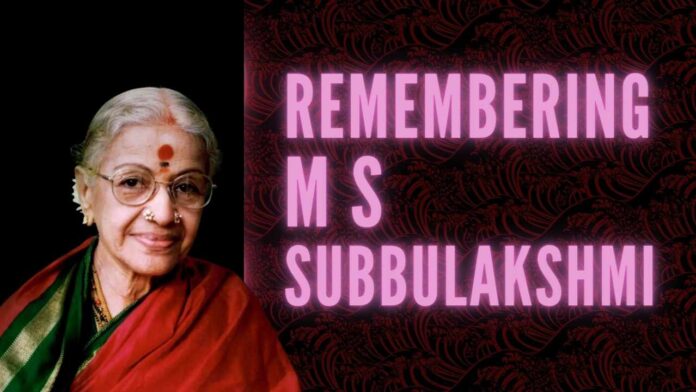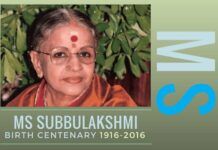
Remembering the Iconic M S Subbulakshmi on her birth anniversary
M S Subbulakshmi: At the crack of dawn across lakhs and lakhs of Bharatiya households every day, a divine voice gently rouses Mahavishnu with her rendering of Suprabhatam. The sublime voice belonged to the immensely popular and much-loved M S Subbulakshmi.
Kunjamma, as she was fondly called by her family, was born on 16 September 1916 in Madurai to Shanmugavadivu Ammal and Subramanya Iyer. Born in a family belonging to the Devadasi tradition, her mother being a veena player and her maternal grandmother a violinist, music came very naturally for Kunjamma. Above this, interacted and was involved in discussing music with greats such as Karaikudi Sambasiva Iyer, Mazhavarayanendal Subbarama Bhagavatar, and Ariyakudi Ramanuja Iyengar contributed immensely to her profundity of musical knowledge. From a tender age, she began learning Carnatic music from her mother. A prodigy, she was soon training under Semmangudi Sreenivasa Iyer who is known as the Pitamaha of Carnatic music. Later, she got trained in Hindustani classical music under Pandit Narayanrao Vyas.
She gave her first performance at the age of 11 at Trichy Rockfort temple with well-established seniors such as Mysore Chowdiah on the violin and Dakshinamurthy Pillai on Mridangam as accompanists. Having moved to Chennai, she performed at Music Academy, which is still considered among the most prestigious places to perform, at the age of 13. This was a breakthrough performance, the bhajans that she sang were rendered in a such high calibre that reviewers and critics called her a genius. By the time she turned 17, she was performing regularly with senior artists. Her popularity soared and soon was referred to as ‘MS’ by her adoring fans.
In 1936 she starred in her first film, Sevasadanam, which went on to become a critical as well as a commercial success. She later acted in a few movies including Sakuntalai, Savitri (in which she played the role of sage Narada), Meera (Tamil, 1945), Meerabai (Hindi, 1947), and 1000 Thalai Vaangi Apoorva Chintamani. Her role as Meera is iconic, to say the least. Those who have watched her films or listened to the songs sung by Meera in the film, find it impossible to separate Meera and MS – such is her depth of performance and singing while bringing alive on screen the life of the Krishna bhakta who lived centuries of before. She wound up her acting career afterward to focus entirely on singing.
In 1940 she married T Sadasivan becoming his second wife and mother to his two daughters – Radha and Vijaya – by his first wife who had passed away. She had earlier met Sadasivan – who had co-founded the popular Tamil journal ‘Kalki along with Krishnamurti – and was much in agreement with his nationalistic views. Daughter Radha, who matured into a lovely musician, would sing with MS in practically all the concerts.
MS represented our country as its cultural ambassador. In 1963, she performed at the Edinburgh International Festival and, after this, she was repeatedly invited to tour many parts of the US and Canada, Europe, and Asia to perform. She performed at Carnegie Hall, New York, Royal Albert Hall, London, and at the Festival of India in Moscow apart from the UN General Assembly.
MS was perhaps more associated with bhakti than with the technicality of Carnatic rendering. Her singing had something beyond technicality, ‘something’ that captured the soul of the words that she sang rather than merely their sounds, it was this ethereal ‘something’ that drew everyone spontaneously to her singing, this ‘something’ that still makes people search for her rendering of bhajans despite there being several others who might have also sung them! It was this same ‘something’ that was in play when she sang ‘Maitreem Bhajata’ written by Kanchi Mahaperiyavar Jagadguru Sri Chandrasekhara Saraswati at the UN in 1966 on the occasion of UN Day. The Sanskrit song was a benediction that called for Universal Wellbeing which underlies the ethos of Sanatana Dharma and received a standing ovation for her soul-lifting rendition. Earlier, when U-Thant invited MS to perform, she and her husband accepted and immediately went to seek the blessings of Mahaperiyavar at Kanchi, whose ardent devotees they were. Mahaperiyava asked MS to sing Maitreem Bhajata as an anthem for universal friendship.
MS was a deeply pious person and highly dedicated to studying music. She would not sing any song unless she had learned the song thoroughly, including the meaning of the song. She spent months learning the accurate pronunciation to be used from Sanskrit scholars before she recorded the Suprabhatam which has since become a common morning ritual in crores of Hindu households all over the globe. A few of the popular songs that she sang such as Bhaja Govindam, Kurai Ondrum Illai, Hanuman Chalisa, Vishnu Sahasranamam, and Vaishnava Jana To and immensely popular to this day! A less-known fact is that she sang an English hymn, ‘May the Lord forgive’ written by Rajagopalachari and set to music by Manuel Handel in Russia; this song is set to western music! She considered herself a learner all her life. Daughter Radha was her only student.
MS was also extremely charitable and quietly gave away big parts of her performance earnings to serve several causes. She raised money to build the Tamil Isai Sangam to promote ancient Tamil as a musical language that had been side-lined by Telugu. Music Academy which held on to puritan ideas was against MS and threatened to boycott her but, in a few years, MS was raising funds for Music Academy to help build their auditorium! It was while inaugurating this auditorium that Jawaharlal Nehru said, “Who am I? A mere Prime Minister in front of this Queen of song!” Lata Mangeshkar would call her ‘Tapaswini’ and Ustad Bade Ghulam Ali called her ‘Suswaralakshmi’.
MS continued to sing for charitable causes despite the Sadasivams’ dwindling savings. The money earned from the recordings of Venkateswara Suprabhatam, Bhaja Govindam, Vishnu Sahasranamam, and many other songs went to charity. She also sang to raise money for Memorial Funds in honour of Kasturba Gandhi. She would perform in packed auditoriums and open amphitheaters where tickets were sold for very small amounts – so that nobody was denied the joy of listening to her – to raise the amount for public causes of which education and healthcare were her favourite. The list of her charity concerts is very long, Indira Menon, the author of Women In Karnatak Music lists at least 200 at the end of her book!
In the year 1997, Sadasivam passed away and MS did not give public performances after this. MS died on 11 December 2004 at the age of 88.
MS received many prestigious awards. In 1968, the Music Academy that had once threatened to boycott her gave her the Sangeeta Kalanidhi Award, an honour that was hitherto reserved exclusively for males, and yet, she was unanimously chosen to become the first woman to receive this award.
In 1974, she received the Ramon Magsaysay Award for Charity, the first Indian musician to get it.
The Government of India honoured her with the Padma Bhushan in 1954, the Padma Vibhushan in 1975, and with Bharat Ratna in 1998. She was the first musician to receive the Bharat Ratna.
In 1956, she received the Sangeet Natak Akademi Award, the highest recognition the academy gives to people in the field of performing arts. She received the Sangeeta Kalasikhamani instituted by the Indian Fine Arts Society, Chennai in 1975. The Govt of Madhya Pradesh honoured her with the Kalidas Samman Award in 1988.
She was honoured as the Asthana Vidwan (an artist who is attached to the temple) of Tirumala Tirupati Devasthanams. Tirumala Urban Development Authority has installed a bronze statue of M S Subbulakshmi at the Pornakumbha circle at the temple town which was unveiled on 28 May 2006 by CM Y S Rajashekhara Reddy.
A commemorative stamp was issued by the Government of India in December 2005. On her birth centenary, the UN issued a stamp in her honour.
In addition to her divine music, MS remains an idol of tradition carried in the most beauteous manner, grace, humility, and utmost surrender. She was a gem of a queen indeed!
Note:
1. Text in Blue points to additional data on the topic.
2. The views expressed here are those of the author and do not necessarily represent or reflect the views of PGurus.
PGurus is now on Telegram. Click here to join our channel and stay updated with all the latest news and views
For all the latest updates, download PGurus App.
- M S Subbulakshmi aka “MS”: ‘Suswaralakshmi’, ‘Tapaswini’ of divine voice - December 11, 2022








